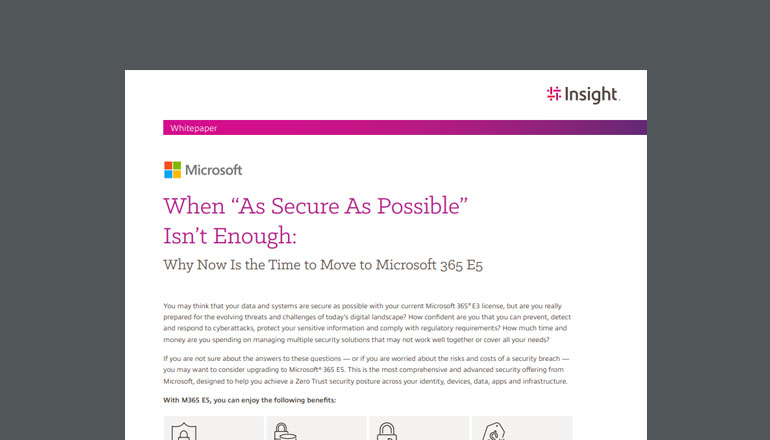Article Are Your Devices a Threat to Your Security?
By Insight Editor / 15 Apr 2025 / Topics: Devices Cybersecurity

Securing devices can be compared to securing a car. You can have a state-of-the-art anti-theft system and the best insurance, but leaving the doors unlocked and keys inside renders them ineffective. Today’s device security challenges often compel organizations to leave their “keys” accessible and “doors” unsecured.
Your organization invests in device security, but there are numerous issues: legacy technology challenges, knowledge and resources gaps, and the need to pay ongoing attention to updates, policies, and more. Just one vulnerable device can damage your organization’s reputation and cost valuable time and money.
Let’s look at how to mitigate the most common device vulnerabilities.
68% of organizations have experienced one or more endpoint attacks that successfully compromised data.1
The impact of human error on your security
We’re all human. We make mistakes and simple errors, but when it comes to cybersecurity, it can cost you. In 2024, approximately 88% of cybersecurity breaches were caused by human error.2 It’s important for your end users to consider your organization’s device security. It can protect your personal information and your organization’s critical information from being compromised. Modern authentication is a great place to start as the foundation of your device security.
The impact of malicious software on your security
Malicious software — including malware, ransomware, and viruses — can infiltrate your organization. These attacks can lead to data theft, loss of control over your devices, and damage to your network.
These breaches are impactful in the moment but can also have long-term impacts on your organization. Reputation damage, loss of trust in your organization, and increased vulnerability to additional attacks are important concerns to note when it comes to malicious software.
The impact of legacy technology on your security
The threat of cyberattacks will never completely go away, but one of the easiest ways for them to infiltrate your environment is through devices on legacy operating systems. These devices can be the weakest link in the chain and cause massive security gaps in your organization.
One major upcoming vulnerability you may face is Windows 10’s end of support on October 14, 2025. After October 2025, Windows 10 will no longer receive security updates that protect your organization and end users, exposing you to threats and costing you money.
Fortunately, the protections built into modern operating systems such as Windows 11 ladder up to a secure-as-possible strategy. Windows 11’s suite of advanced features provide protection at every level. If you keep Windows 10 past its support date, you will not only be missing out on the benefits of Windows 11, you will also be using inherently vulnerable machines.
How to strengthen your device security
Human errors, malicious software, and legacy technology will be ongoing vulnerabilities for your organization. That’s why it’s important to know how you can reduce and limit their associated risks.
Mitigating human error and malware
We’re all human — but avoiding simple end-user mistakes can make all the difference in keeping your organization secure. Phishing and social engineering tactics are becoming more advanced. Weak passwords are, unfortunately, still very common. The most common ways to reduce the risk of human error include:
- Having a robust cybersecurity training program that is engaging and includes regular phishing simulations
- Going beyond multifactor authentication and employing passwordless authentication
- Keeping an eye on the next big thing in authentication: continuous authentication, which monitors user behavior in real-time — analyzing and predicting the user’s behavior to certify they are the authorized user for that device
Minimizing the threat of malicious software requires a combination of tactics: proactive security measures, user awareness, and technical tools. Let’s look at a few ways to effectively minimize the risk of malware:
- Regular updates, automated patching of operating systems, and device policies that verify devices are actually receiving updates
- Antivirus software may seem obvious, but installing security software on your devices can help scan, detect, and protect from threats
- Device encryption, such as BitLocker, makes data inaccessible to unauthorized users in the event a device is lost or stolen
Develop device security baselines.
The cybersecurity industry has a talent shortage of almost four million professionals.3
A strong security posture requires skills, knowledge, and time to deploy. Many organizations face challenges in keeping ahead of threats with limited resources and outdated knowledge. Partnering with a trusted adviser like Insight can help.
Insight assists clients in securing their devices with access to experts and lifecycle and managed services, all supported by our strong OEM partnerships. With more than 6,000 skilled professionals, we help clients achieve their security goals.
Protect your end users from modern threats — contact an Insight specialist today.
1Harris, C. (2025, Jan. 3). 50 Endpoint Security Stats You Should Know in 2025. Expert Insights.
2Sobers, R. (2024, Sept. 13). 157 Cybersecurity Statistics and Trends. Varonis.
3Borgeaud, A. (2025, Feb. 26). Cybersecurity Workforce Gap Worldwide in 2024, By Region. Statista.






